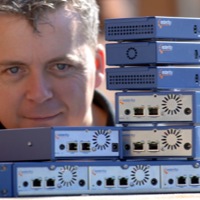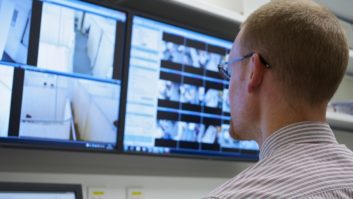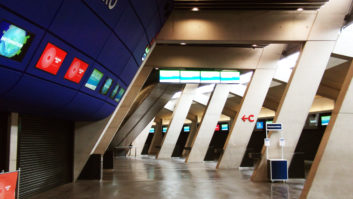
As the number of market sectors embracing IPTV grows, installers must embrace the world of IT if they are to grab a share of this growing market, George Cole reports. Internet protocol television (IPTV) is often used in the telecom and cable TV sectors to deliver TV services to homes. Now, the service is becoming ever-present in the business, corporate and education sectors for a wide range of applications – including live and recorded TV, corporate video, video-on-demand and digital signage, with it able to distribute not just information, but entertainment and training content to a wide range of devices, from large-screen stadium displays to televisions, and from desktop PCs to tablet computers. Rainer Link, responsible for international sales and marketing at Teracue AG – broadcast and IPTV systems, says: “We are seeing widespread IPTV applications in a mix of sectors that includes corporate, education, government and military installations, broadcast, entertainment, hospitality and digital signage.” Philip Dodds, business development director, Vision2 Group, AMX Europe, agrees that IPTV is being used in many applications. “The advent of IP networks throughout most organisations enables the simple and effective delivery of video across the LAN [local area network],” he says. “One of the sectors currently evaluating and implementing IPTV systems is the medical arena, especially in the area of operating theatres. Quite often, we will see several cameras being used in the operating theatre, and IPTV allows the streaming and recording of the medical operations in high definition, so that students and doctors can learn from the experts.” Dodds adds that schools and universities are using IPTV for distance learning, such as watching live streams or accessing video-on-demand content. “We recently implemented a classroom recording system that helps students with learning difficulties understand and copy how to complete a food preparation exercise,” he says. “The teacher performs a task, which is recorded and made available to the students as a video clip.” Main markets Colin Farquhar, CEO of Exterity, says that, for his company, the main IPTV applications are in corporate television (such as banks and finance houses), education (schools, colleges and universities) and the hospitality sector. “We’re also seeing IPTV being deployed in large public spaces, such as airports and football stadiums,” he adds. Mike Cuckow, sales director EMEA and Asia-Pacific at Cabletime, observes: “IPTV is being used in the accommodation sector, such as university blocks, military bases, special hospitals and hotels. Stadiums are another sector, and a lot of WAN [wide area network]-based corporates are also using IPTV.” Don Hewitt, customer solutions manager at Harris Broadcast Communications, notes: “From our perspective, the two main sectors for IPTV are hotels and sports stadiums, which use it for digital signage. For hotels, IPTV-based digital signage represents an important window to customers in the form of highly branded internal information channels.
These channels allow hotels to promote their services to guests in a far more engaging way than the standard ‘slide show’. As new sports facilities and stadiums are constructed, there is a greater need to engage, inform and entertain fans. IPTV represents a very cost-effective method of distributing content while maintaining quality. This is especially true when IPTV and digital signage are integrated into a media platform.” Gaining support The growth of IPTV is being driven by a number of factors, including the fact that many networks support the protocols required for IPTV, including IGMP (internet group management protocol), which is used for multi-casting. Potential cost savings and simplicity are also strong drivers, says Link. “Today’s IP-based networks make it very easy to place video applications on them, so most of the time it is not necessary to invest in a dedicated technology, traditional AV distribution or extensive cabling,” he explains.
Farquhar notes: “Traditionally, organisations used an analogue TV distribution system, modulating TV content onto coax, or perhaps some form of digital transmission over coax or Cat5 cabling. As soon as you put content on a network, it’s more accessible. Whereas in the past, I might bring two channels into my building and display the content (such as news channels) on a couple of TV screens, now I can distribute content to every room, and potentially every device connected to the network, whether it’s a TV or a PC or some other display device. That’s an exciting development.” IPTV means organisations can get even more value out of their IT infrastructure, and in the hospitality world, IPTV can be used to deliver combined services like TV and internet, and improve the quality of the delivered content, adds Farquhar: “In many hotels, the TV signal is degraded by noise from air-conditioning systems and appliances. IPTV allows you to deliver a much cleaner signal to the end-user. And being able to use the existing infrastructure is very convenient for large public spaces, like airports and stadiums.” Dodds adds: “We’re seeing all new office builds being specified with an IPTV element, as this technology takes advantage of new IP network infrastructures being installed. The same goes for offices being refitted, updated or refurbished, where an updated network infrastructure is being implemented in place of the old analogue UTP cabling. It means support teams need only concern themselves with one network infrastructure, which ensures much more cost effectiveness. One of the other main advantages is that an IP video delivery infrastructure has limitless scalability.” “IPTV gives you the ability to take a digital signal from the roof and put it onto your network with no loss in quality,” notes Cuckow. “People can watch web TV on their PC in the workspace without consuming additional internet bandwidth. This reduces costs, and gives you the ability to control what TV is watched over the network and by whom. Factors like these make IPTV a very attractive prospect to organisations.” Some companies are using IPTV to consolidate their business, adds Cuckow, for example, using a single head-end to feed video streams to the company WAN. If the company later decides to close branch offices and gather employees into a single building, the IPTV system becomes a LAN-based service. Another IPTV driver is the advent of Cloud-based media, says Cuckow: “People are used to storing a mix of media in the cloud at home – such as videos, photographs and music – and they want the same level of access in the office, which IPTV can provide.” Growth expectationsThose involved in the IPTV business see much scope for growth in the market. “We estimate that the global IPTV market will grow from around $750 million in 2011 to $1.4 billion in 2015,” says Farquhar. “Most video distribution systems are moving to IPTV. The growing use of iPads and other wireless network devices in the corporate sector is also creating additional demand for IPTV.” Link says that since 2005, Teracue has seen a constant growth in IPTV, thanks to its ability to offer flexible, scalable and cost-efficient AV distribution and transmission technology. “Most market sectors will see a shift from the old traditional analogue implementation to IP based video delivery,” says Dodds, “there will definitely be an expansion of IP video delivery in all market sectors. Education is likely to carry on expanding its use of video. In education, it’s not just about supporting Windows PCs any more; the explosion of use of Apple devices has led to IT teams having to ensure their infrastructures support these as well.” “There are a few factors driving the IPTV market for digital signage. Not only is the decoder a low-cost alternative, but the infrastructure and cabling of a new build out are also cheaper,” says Hewitt. “Gigabit Ethernet is a common network speed, so there is plenty of bandwidth to multicast HD video and there’s lots of flexibility.” With the IPTV market expected to show significant growth, is there an opportunity for the AV installers to move into the sector? “It is an exciting opportunity for AV installers,” says Hewitt. Link agrees: “There is a big opportunity for IPTV with AV installers, but the AV installers have to grow their knowledge of IT and networking technology, otherwise, the IT people will take over the AV skills. Streaming is based on the network, and whoever controls the network controls the streaming. AV system integrators today need to speak and understand IT and network language in order to participate; otherwise they won’t be able to compete. The AV installers who have recognised this fact and who have invested in training, know-how and staff are way ahead of the competition.” Embracing IT“Many AV installers still shy away from too much involvement with IP,” notes Dodds, “so there is a considerable opportunity for those willing to get to grips with understanding and implementing IPTV solutions to differentiate themselves from their competitors. Even just understanding and being able to articulate the relative benefits of IPTV will at least open conversations with consultants and clients. An IPTV system can also be a door opener to more traditional AV solutions and lead to further opportunities. Many IPTV systems can be more or less plug-and-play, the critical issue is ensuring that the client IP network is ready and configured, but there’s plenty of documentation available to help in the planning and installation.” Cuckow agrees that there is a big opportunity for AV installers to move into IPTV, but urges caution, not least when it comes to ensuring that a client’s LAN is IPTV-ready. “Anyone can provide the tools and a tick-list to assess LAN readiness [for IPTV], but the big flaw to this approach is that the client may not fully understand the LAN they’ve got, or it might be owned by a third party, who simply ticks the boxes without doing the checks,” he says. “Then the AV VAR walks into a nightmare. The same problem can hit an IT VAR, but the difference is that they will have the in-house resources to fix the problem.” That’s why, he adds, it’s important for AV installers to employ staff with IT fault-finding skills: “Some AV VARs want a long-term relationship with a client and will bend over backwards to accommodate their needs. But this costs them money while others put a clause in their contract which states that if the network is not ready, it will charge the client. This has the advantage of concentrating the mind of the client, and as a result, they are more likely to check the readiness of the LAN.” “There’s definitely an opportunity for AV installers,” says Farquar, “but it’s important to remember that there are different levels of IPTV deployment. For example, we installed a system at Heathrow airport, which involved a close working relationship between integrator, reseller, installer and the IT department. This type of installation requires a high degree of IT knowledge and experience, and it’s unlikely that any AV installer would want to jump into a project like this, unless they were partnering someone. One way would be to start small, say, delivering a single IPTV channel to a single end-point, and from there, you can rapidly move onto larger and more complex projects.” Exterity runs the StreamForce training programme for IT companies to gain knowledge of video, and for AV companies to learn about IPTV. “The key is to walk before you can run, “ says Farquhar. “There are significant opportunities for AV installers but, equally, there’s a need to take the appropriate steps and get the right training, support and assistance, so you can get some successes and grow a set of skills. IPTV isn’t a black art, but as soon as you start putting things onto a network, many organisations become very sensitive because the network carries all their data and they want to be confident that the people giving them advice have a good understanding of what they are doing.”
Picture courtesy of UKA www.amx.comwww.cabletime.comwww.exterity.comwww.broadcast.harris.comwww.teracue.com







